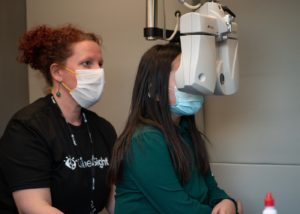What To Expect in an Eye Exam

However, if you’ve never had one before, the prospect of an eye exam can be a little daunting, or even anxiety-inducing. To calm your nerves and ensure that the process goes as smoothly as possible, it can be helpful to have an idea of what to expect.
Who Needs an Eye Exam?
The American Academy of Ophthalmology recommends that everyone get a complete eye exam by the age of 40, even if they have good vision. For people with existing conditions or a history of eye disease, annual or bi-annual exams may be recommended. If you meet any of the following criteria, it might be a good idea to check with an eye doctor to see if an exam is needed:
- You have existing vision problems or are experiencing worsening vision
- Your family has a history of eye disease
- You have diabetes
- You are of Mexican American or African American descent
Who Conducts Eye Exams?
Both optometrists and ophthalmologists can conduct eye exams. Often, they will be assisted by technicians, who may perform parts of the exam for them.
What Happens in an Eye Exam?
Eye exams might comprise a variety of tests or procedures depending on your specific needs and concerns. However, you can generally count on receiving a visual acuity test, in which you’ll be asked to read a series of increasingly smaller letters off of a chart to test your vision. In addition to a vision exam, your eye exam might include any of the following:
- Eye muscle test
- Refraction assessment
- Visual field test
- Color vision testing
- Slit-lamp examination
- Retinal examination
- Glaucoma screening
- Ophthalmoscopy
- Tonometry
Do Eye Exams Hurt?

OneSight is on a mission to help the world see better by bringing affordable vision care to those who need it most. Since 1988, we’ve reached 52+ million people worldwide, including lives served directly as well as people who now have ongoing access to vision care through permanent vision centers. Our strategy is focused on both meeting immediate needs and establishing long-term solutions, and involves a combination of charitable clinics and sustainable vision centers. Contact us for more information about how you can make a difference in ending the vision care crisis, or consider donating to support our work.